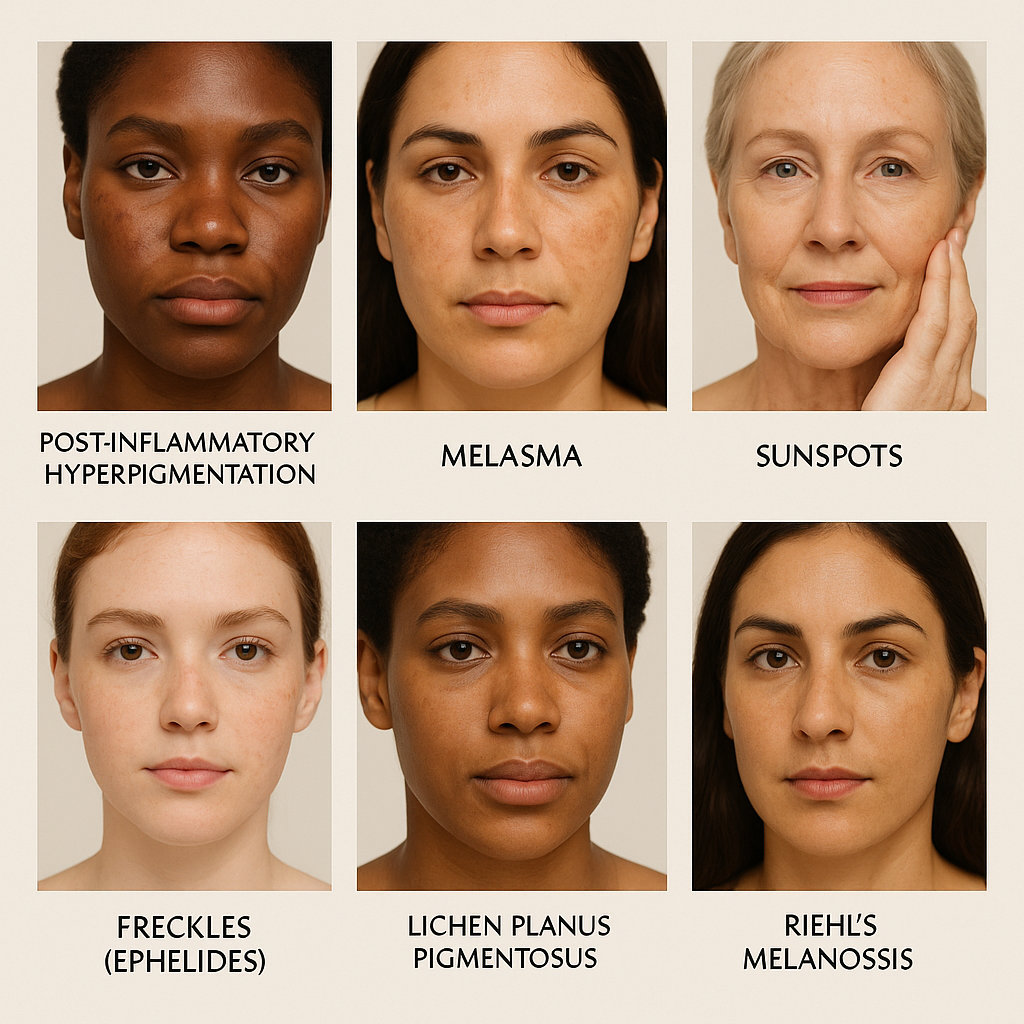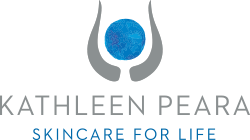
By KATHLEEN PEARA SKINCARE FOR LIFE
What Is Hyperpigmentation?
Hyperpigmentation is a common skin concern where patches of skin become darker than the surrounding area due to excess melanin production. While it can affect all skin tones, the causes, appearance, and response to treatment vary significantly between lighter skin and melanin-rich skin.
Types of Hyperpigmentation
1. Post-Inflammatory Hyperpigmentation (PIH)
- Triggered by inflammation (acne, eczema, injury)
- Common in melanin-rich skin, appearing brown, blue, or gray
2. Melasma
- Hormone-related pigmentation, often worsened by sun exposure
- Affects women more than men, particularly during pregnancy or with contraceptives
3. Sunspots / Solar Lentigines
- Caused by UV damage over time
- More visible on lighter skin but can also affect darker skin types
4. Freckles (Ephelides)
- Genetic and sun-related
- Common in lighter skin tones
5. Lichen Planus Pigmentosus / Riehl’s Melanosis
- Specific forms of pigmentation seen more frequently in melanin-rich skin
- Can result from inflammation or fragrance/allergen exposure
Differences in Light Skin vs. Melanin-Rich Skin
| Feature | Light Skin | Melanin-Rich Skin |
|---|---|---|
| Melanin Type | Mostly pheomelanin | Higher eumelanin |
| Inflammatory Response | Less prone to PIH | More prone to PIH |
| Treatment Sensitivity | Higher risk of redness/irritation | Higher risk of scarring and rebound pigmentation |
| Laser & Peel Risks | Higher risk of burns | Higher risk of PIH and hypo/hyperpigmentation |
| Best Approach | Gentle exfoliation, antioxidants | Barrier repair, anti-inflammatory actives |
Medical Treatments for Hyperpigmentation
Topical Prescription Agents:
- Hydroquinone (2%-4%): Gold standard but regulated in many countries due to potential side effects
- Tretinoin / Retinoids: Promotes cell turnover; often combined with hydroquinone or corticosteroids (e.g., Tri-Luma®)
- Azelaic Acid (15%-20%): Effective and well-tolerated in melanin-rich skin
- Corticosteroids (short-term use): Anti-inflammatory for melasma/PIH
- Tranexamic Acid (topical or oral): Especially useful in melasma
Procedures (medical supervision required):
- Chemical Peels (e.g., TCA, glycolic acid): Light-medium depth only under professional care
- Laser Treatments: Caution with melanin-rich skin; devices like Q-switched Nd:YAG or Pico laser used at lower settings
- Microneedling with lightening serums: Emerging approach with fewer pigment risks
| Niacinamide (Vitamin B3) | Reduces transfer of melanin to skin cells |
| Kojic Acid | Fungal-derived pigment suppressor |
| Licorice Root Extract | Soothes and brightens |
| Hexylresorcinol | Blocks multiple melanin pathways |
Cosmeceutical Approaches & Ingredients
Brightening Ingredients:
| Ingredient | Function |
|---|---|
| Alpha Arbutin | Tyrosinase inhibitor, gentler than hydroquinone |
| Niacinamide (Vitamin B3) | Reduces transfer of melanin to skin cells |
| Kojic Acid | Fungal-derived pigment suppressor |
| Licorice Root Extract | Soothes and brightens |
| Hexylresorcinol | Blocks multiple melanin pathways |
| Vitamin C (L-Ascorbic Acid / derivatives) | Antioxidant and tyrosinase inhibitor |
| Resveratrol | Antioxidant and melanin modulator |
Peptides with Brightening Properties:
- Melanostatine™-5: Inhibits melanin biosynthesis
- Oligopeptide-68: Targets melanin at the genetic transcription level
Internal Supplements and Ingestible Pigment Inhibitors
While not a primary therapy, internal support for pigment control is growing:
Oral Pigment Modulators:
- Tranexamic Acid (250 mg 2x daily): Used under doctor supervision for melasma
- Polypodium Leucotomos Extract (PLE): Antioxidant protection against UV-induced pigmentation
- Glutathione: Skin-lightening antioxidant with mixed clinical results
- Vitamin C + E: Supports antioxidant balance and reduces melanin synthesis
Dietary Considerations:
- High-antioxidant foods: Berries, green tea, turmeric, tomatoes
- Avoid inflammation triggers: Processed sugars, trans fats, allergens
Hyperpigmentation Protocol: A Holistic Approach
For Lighter Skin Tones:
- Gentle exfoliation (lactic/glycolic acids)
- Antioxidants (Vitamin C, ferulic acid)
- Niacinamide for pigment regulation
- SPF 50+ with iron oxide for added UVA/visible light protection
For Melanin-Rich Skin:
- Anti-inflammatory focus: Azelaic acid, niacinamide, green tea
- Barrier repair: Ceramides, peptides, panthenol
- Avoid aggressive lasers or deep peels
- SPF with blue light protection (zinc oxide + iron oxide preferred)
Cautions and Considerations
- Sun protection is non- negotiable. Even the most advanced pigment treatments can fail without diligent daily SPF use.
- Avoid DIY peels or unregulated bleaching creams.
- Always patch test and work with a licensed professional—especially for melanin-rich skin, where improper treatment can cause long-lasting damage.
KATHLEEN PEARA SKINCARE FOR LIFE RECOMMENDS:
Explore formulas designed to support pigment balance and overall skin health using the synergy of peptide science and botanical wisdom:
- VITA C+ Collection – Potent antioxidant and peptide complex to visibly brighten and shield the skin from oxidative stress
- SENSI-SKIN Collection – Calm, soothe, and correct pigmentation with inflammation-modulating botanicals such as Defensil®-Soft, arnica, calendula, and green tea
- CLARIFIANCE Collection – Clarify blemish-prone skin while addressing PIH (post-inflammatory hyperpigmentation) with botanical antimicrobials, exfoliating acids, and soothing peptides
- E-TONE Collection – A targeted brightening ritual featuring skin-brightening peptides (like Oligopeptide-68), pigment-regulating ingredients (such as niacinamide and alpha arbutin), and botanical actives (licorice root, daisy flower extract, and bearberry) to help even tone, reduce pigment clustering, and illuminate skin from within
We blend nature’s intelligence with the science of peptides to create rituals that gently brighten and balance skin—across all tones and types.
